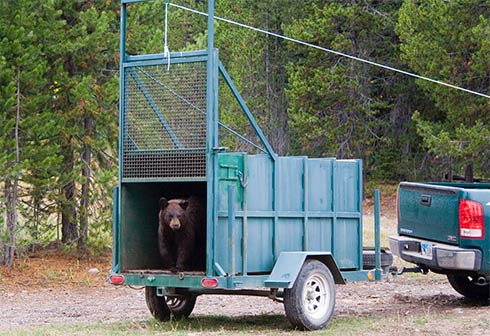
In a strategic move to bolster genetic diversity, two grizzly bears were recently relocated from the Northern Continental Divide Ecosystem (NCDE) to the Greater Yellowstone Ecosystem (GYE). We will explore the journey of these bears, their adaptation, and the broader implications for grizzly bear conservation.
Grizzly Bear Translocation: A Step Towards Genetic Health
The project involved relocating a 3-4 year old female and a 4-5 year old male grizzly bear from near East Glacier in Montana’s Middle Fork of the Flathead River drainage. Captured in July, these subadult bears were transported overnight to their new habitats within the GYE. The male bear was released at the southern end of Yellowstone Lake, while the female was placed in the Blackrock Creek drainage west of Dubois, Wyoming.
Tracking the Bears
Both bears have been equipped with GPS collars, allowing researchers to monitor their movements. A detailed map reveals the fascinating paths these animals have taken: the female’s journey is marked by wide loops, indicating exploration, while the male’s is more concentrated, suggesting he has found a suitable range. Despite their close proximity at times, their paths have only rarely intersected, showcasing their natural behavior in a new environment.
Why Subadult Bears?
Ken McDonald, head of Montana Fish, Wildlife & Parks’ Wildlife Division, emphasized the choice of subadult bears for this translocation. These bears are ideal as they are in the process of establishing their own territories, making them more likely to stay in the GYE rather than return to their original habitat. Additionally, these bears had no history of conflict, ensuring a smoother integration into their new environment.

Adaptation and Monitoring
Cecily Costello, a grizzly bear researcher at FWP, reported that both bears appear to be adjusting well, with indications that they have already settled into den sites for the winter. This positive adaptation is a promising sign for the success of the project.
Conservation Context
The grizzly bear populations in both the NCDE and GYE have surpassed recovery goals, leading to discussions about delisting them from federal protection under the Endangered Species Act. Montana and Wyoming, with Idaho’s support, have addressed all necessary criteria for delisting, including population recovery, conflict management, research, and education. This translocation project is part of a commitment to maintain genetic connectivity and health among bear populations.
Looking Forward
Continuous monitoring will help assess the long-term success of this initiative. If these bears continue to thrive, similar efforts might be repeated, supporting both the ecological balance and the potential for delisting grizzly bears in these regions.
The translocation of these grizzly bears is more than just a relocation; it’s a strategic move for conservation, offering insights into bear behavior, adaptation, and the importance of genetic diversity. As these bears explore their new territories, they contribute to the rich tapestry of the Greater Yellowstone Ecosystem.
- Health Officials Urge Radon Testing - January 6, 2026
- Jackson Hole Artist Nani Chacon Selected for 2026 Whitney Biennial - December 26, 2025
- Beloved Jackson Hole Radio Personality Del Ray John Passes Away at 80 - December 11, 2025
